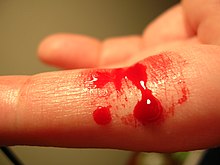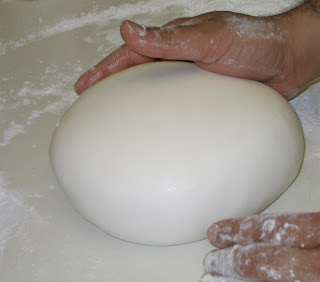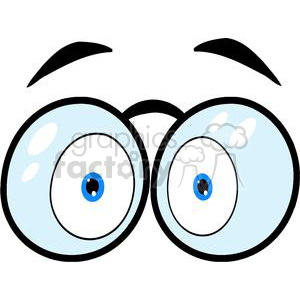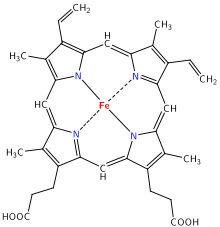In vertebrates, it is composed of blood cells suspended in a liquid called blood plasma. Plasma, which constitutes 55% of blood fluid, is mostly water (92% by volume),[1] and contains dissipated proteins, glucose, mineral ions, hormones, carbon dioxide (plasma being the main medium for excretory product transportation), platelets and blood cells themselves. Albumin is the main protein in plasma, and it functions to regulate the colloidal osmotic pressure of blood. The blood cells are mainly red blood cells (also called RBCs or erythrocytes) and white blood cells, including leukocytes and platelets. The most abundant cells in vertebrate blood are red blood cells. These contain hemoglobin, an iron-containing protein, which facilitates transportation of oxygen by reversibly binding to this respiratory gas and greatly increasing its solubility in blood. In contrast, carbon dioxide is almost entirely transported extracellularly dissolved in plasma as bicarbonate ion.
Vertebrate blood is bright red when its hemoglobin is oxygenated. Some animals, such as crustaceans and mollusks, use hemocyanin to carry oxygen, instead of hemoglobin. Insects and some mollusks use a fluid called hemolymph instead of blood, the difference being that hemolymph is not contained in a closed circulatory system. In most insects, this "blood" does not contain oxygen-carrying molecules such as hemoglobin because their bodies are small enough for their tracheal system to suffice for supplying oxygen.
Blood is circulated around the body through blood vessels by the pumping action of the heart. In animals with lungs, arterial blood carries oxygen from inhaled air to the tissues of the body, and venous blood carries carbon dioxide, a waste product of metabolism produced by cells, from the tissues to the lungs to be exhaled.
Medical terms related to blood often begin with hemo- or hemato- (also spelled haemo- and haemato-) from the Ancient Greek word αἷμα (haima) for "blood". In terms of anatomy and histology, blood is considered a specialized form of connective tissue, given its origin in the bones and the presence of potential molecular fibers in the form of fibrinogen.
Functions

Hemoglobin
green = heme groups
red & blue = protein subunits
Blood performs many important functions within the body including:
- Supply of oxygen to tissues (bound to hemoglobin, which is carried in red cells)
- Supply of nutrients such as glucose, amino acids, and fatty acids (dissolved in the blood or bound to plasma proteins (e.g., blood lipids))
- Removal of waste such as carbon dioxide, urea, and lactic acid
- Immunological functions, including circulation of white blood cells, and detection of foreign material by antibodies
- Coagulation, which is one part of the body's self-repair mechanism (blood clotting after an open wound in order to stop bleeding)
- Messenger functions, including the transport of hormones and the signaling of tissue damage
- Regulation of body pH
- Regulation of core body temperature
- Hydraulic functions
[edit] Constituents of human blood

Two tubes of
EDTA-anticoagulated blood.
Left tube: after standing, the RBCs have settled at the bottom of the tube.
Right tube: contains freshly drawn blood.
Blood accounts for 8% of the human body weight,
[3] with an average density of approximately 1060 kg/m
3, very close to pure water's density of 1000 kg/m
3.
[4] The average adult has a
blood volume of roughly 5
liters (1.3 gal), composed of plasma and several kinds of cells (occasionally called
corpuscles); these formed elements of the blood are erythrocytes (
red blood cells, RBCs), leukocytes (
white blood cells), and thrombocytes (
platelets). By volume, the red blood cells constitute about 45% of whole blood, the plasma about 54.3%, and white cells about 0.7%.
Whole blood (plasma and cells) exhibits
non-Newtonian,
viscoelastic fluid dynamics; its flow properties are adapted to flow effectively through tiny capillary blood vessels with less resistance than plasma by itself. In addition, if all human hemoglobin were free in the plasma rather than being contained in RBCs, the circulatory fluid would be too viscous for the cardiovascular system to function effectively.
One microliter of blood contains:
- 4.7 to 6.1 million (male), 4.2 to 5.4 million (female) Erythrocytes:[5] Red blood cells contain the blood's hemoglobin and distribute oxygen. Mature red blood cells lack a nucleus and organelles in mammals. The red blood cells (together with endothelial vessel cells and other cells) are also marked by glycoproteins that define the different blood types. The proportion of blood occupied by red blood cells is referred to as the hematocrit, and is normally about 45%. The combined surface area of all red blood cells of the human body would be roughly 2,000 times as great as the body's exterior surface.[6]
- 4,000–11,000 Leukocytes:[7] White blood cells are part of the body's immune system; they destroy and remove old or aberrant cells and cellular debris, as well as attack infectious agents (pathogens) and foreign substances. The cancer of leukocytes is called leukemia.
- 200,000–500,000 Thrombocytes:[7]: Also called platelets, thrombocytes are responsible for blood clotting (coagulation). They change fibrinogen into fibrin. This fibrin creates a mesh onto which red blood cells collect and clot, which then stops more blood from leaving the body and also helps to prevent bacteria from entering the body.
Constitution of normal blood
| Parameter | Value |
| Hematocrit | 45 ± 7 (38–52%) for males
42 ± 5 (37–47%) for females |
| pH | 7.35–7.45 |
| base excess | −3 to +3 |
| PO2 | 10–13 kPa (80–100 mm Hg) |
| PCO2 | 4.8–5.8 kPa (35–45 mm Hg) |
| HCO3− | 21–27 mM |
| Oxygen saturation | Oxygenated: 98–99%
Deoxygenated: 75% |
[edit] Plasma
About 55% of whole blood is
blood plasma, a fluid that is the blood's liquid medium, which by itself is straw-yellow in color. The blood plasma volume totals of 2.7–3.0 liters (2.8–3.2 quarts) in an average human. It is essentially an
aqueous solution containing 92% water, 8% blood plasma
proteins, and trace amounts of other materials. Plasma circulates dissolved nutrients, such as
glucose,
amino acids, and
fatty acids (dissolved in the blood or bound to plasma proteins), and removes waste products, such as
carbon dioxide,
urea, and
lactic acid.
The term serum refers to plasma from which the clotting proteins have been removed. Most of the proteins remaining are albumin and
immunoglobulins.
[edit] Narrow range of pH values
Bones are especially affected by blood pH as they tend to be used as a mineral source for pH buffering. Consuming a high ratio of animal protein to vegetable protein is implicated in bone loss in women.
[10][edit] Blood in non-human vertebrates
Human blood is typical of that of mammals, although the precise details concerning cell numbers, size,
protein structure, and so on, vary somewhat between species. In non-mammalian vertebrates, however, there are some key differences:
[11]- Red blood cells of non-mammalian vertebrates are flattened and ovoid in form, and retain their cell nuclei
- There is considerable variation in the types and proportions of white blood cells; for example, acidophils are generally more common than in humans
- Platelets are unique to mammals; in other vertebrates, small nucleated, spindle cells are responsible for blood clotting instead
[edit] Physiology
[edit] Cardiovascular system

The circulation of blood through the human heart
Blood is circulated around the body through
blood vessels by the pumping action of the
heart. In humans, blood is pumped from the strong
left ventricle of the heart through
arteries to peripheral
tissues and returns to the right
atrium of the heart through
veins. It then enters the right
ventricle and is pumped through the
pulmonary artery to the
lungs and returns to the left atrium through the
pulmonary veins. Blood then enters the left ventricle to be circulated again. Arterial blood carries oxygen from inhaled air to all of the cells of the body, and
venous blood carries carbon dioxide, a waste product of
metabolism by
cells, to the lungs to be exhaled. However, one exception includes pulmonary arteries, which contain the most deoxygenated blood in the body, while the pulmonary veins contain oxygenated blood.
Additional return flow may be generated by the movement of
skeletal muscles, which can compress veins and push blood through the valves in veins toward the
right atrium.
[edit] Production and degradation of blood cells
In vertebrates, the various cells of blood are made in the
bone marrow in a process called
hematopoiesis, which includes
erythropoiesis, the production of red blood cells; and
myelopoiesis, the production of white blood cells and platelets. During childhood, almost every human bone produces red blood cells; as adults, red blood cell production is limited to the larger bones: the bodies of the vertebrae, the breastbone (sternum), the ribcage, the pelvic bones, and the bones of the upper arms and legs. In addition, during childhood, the
thymus gland, found in the
mediastinum, is an important source of
lymphocytes.
[13] The proteinaceous component of blood (including clotting proteins) is produced predominantly by the
liver, while hormones are produced by the
endocrine glands and the watery fraction is regulated by the
hypothalamus and maintained by the
kidney.
Healthy
erythrocytes have a plasma life of about 120 days before they are degraded by the
spleen, and the
Kupffer cells in the liver. The liver also clears some proteins, lipids, and
amino acids. The kidney actively secretes waste products into the
urine.
[edit] Oxygen transport

Basic hemoglobin saturation curve. It is moved to the right in higher acidity (more dissolved carbon dioxide) and to the left in lower acidity (less dissolved carbon dioxide)
About 98.5% of the
oxygen in a sample of arterial blood in a healthy human breathing air at sea-level pressure is chemically combined with the Hgb. About 1.5% is physically dissolved in the other blood liquids and not connected to Hgb. The
hemoglobin molecule is the primary transporter of oxygen in
mammals and many other species (for exceptions, see below). Hemoglobin has an oxygen binding capacity of between 1.36 and 1.37 ml O
2 per gram Hemoglobin,
[14] which increases the total
blood oxygen capacity seventyfold,
[15] compared to if oxygen solely was carried by its solubility of 0.03 mL O
2 per liter blood per mmHg
partial pressure of oxygen (approximately 100 mmHg in arteries).
[15]Under normal conditions in adult humans at rest; hemoglobin in blood leaving the lungs is about 98–99% saturated with oxygen, achieving an
oxygen delivery of between 950 - 1150 mL/min
[16] to the body. In a healthy adult at rest,
oxygen consumption is approximately 200 - 250 mL/min,
[16] and
deoxygenated blood returning to the lungs is still approximately 75%
[17][18] (70 to 78%)
[16] saturated. Increased oxygen consumption during sustained exercise reduces the oxygen saturation of venous blood, which can reach less than 15% in a trained athlete; although breathing rate and blood flow increase to compensate, oxygen saturation in arterial blood can drop to 95% or less under these conditions.
[19] Oxygen saturation this low is considered dangerous in an individual at rest (for instance, during surgery under anesthesia. Sustained hypoxia (oxygenation of less than 90%), is dangerous to health, and severe hypoxia (saturations of less than 30%) may be rapidly fatal.
[20]A
fetus, receiving oxygen via the
placenta, is exposed to much lower oxygen pressures (about 21% of the level found in an adult's lungs), and, so, fetuses produce another form of hemoglobin with a much higher affinity for oxygen (
hemoglobin F) in order to function under these conditions.
[21][edit] Carbon dioxide transport
CO
2 is carried in blood in three different ways. (The exact percentages vary depending whether it is arterial or venous blood). Most of it (about 70% to 80%) is converted to
bicarbonate ions
HCO−
3 by the enzyme
carbonic anhydrase in the red blood cells,
[22] by the reaction CO
2 + H
2O → H
2CO
3 → H
+ +
HCO−
3 5% – 10% is dissolved in the
plasma,
[22] and 5% – 10% is bound to
hemoglobin as
carbamino compounds
[22]Hemoglobin, the main oxygen-carrying molecule in
red blood cells, carries both oxygen and carbon dioxide. However, the CO
2 bound to hemoglobin does not bind to the same site as oxygen. Instead, it combines with the N-terminal groups on the four globin chains. However, because of
allosteric effects on the hemoglobin molecule, the binding of CO
2 decreases the amount of oxygen that is bound for a given partial pressure of oxygen. The decreased binding to carbon dioxide in the blood due to increased oxygen levels is known as the
Haldane effect, and is important in the transport of carbon dioxide from the tissues to the lungs. Conversely, a rise in the partial pressure of CO
2 or a lower pH will cause offloading of oxygen from hemoglobin, which is known as the
Bohr effect.
[edit] Transport of hydrogen ions
Some oxyhemoglobin loses oxygen and becomes deoxyhemoglobin. Deoxyhemoglobin binds most of the hydrogen ions as it has a much greater affinity for more hydrogen than does oxyhemoglobin.
[edit] Lymphatic system
In mammals, blood is in equilibrium with
lymph, which is continuously formed in tissues from blood by capillary ultrafiltration. Lymph is collected by a system of small lymphatic vessels and directed to the
thoracic duct, which drains into the left
subclavian vein where lymph rejoins the systemic blood circulation.
[edit] Thermoregulation
Blood circulation transports
heat throughout the body, and adjustments to this flow are an important part of
thermoregulation. Increasing blood flow to the surface (e.g., during warm weather or strenuous exercise) causes warmer skin, resulting in faster heat loss. In contrast, when the external temperature is low, blood flow to the extremities and surface of the skin is reduced and to prevent heat loss and is circulated to the important organs of the body, preferentially.
[edit] Hydraulic functions
The restriction of blood flow can also be used in specialized tissues to cause engorgement, resulting in an
erection of that tissue; examples are the
erectile tissue in the
penis and
clitoris.
Another example of a hydraulic function is the
jumping spider, in which blood forced into the legs under pressure causes them to straighten for a powerful jump, without the need for bulky muscular legs.
[23][edit] Invertebrates
In
insects, the blood (more properly called
hemolymph) is not involved in the transport of oxygen. (Openings called
tracheae allow oxygen from the air to diffuse directly to the tissues). Insect blood moves nutrients to the tissues and removes waste products in an open system.
In many invertebrates, these oxygen-carrying proteins are freely soluble in the blood; in vertebrates they are contained in specialized
red blood cells, allowing for a higher concentration of respiratory pigments without increasing
viscosity or damaging blood filtering organs like the
kidneys.
Giant tube worms have unusual hemoglobins that allow them to live in extraordinary environments. These hemoglobins also carry sulfides normally fatal in other animals.
[edit] Hemoglobin

Capillary blood from a bleeding finger

Venous blood collected during blood donation
Hemoglobin is the principal determinant of the color of blood in vertebrates. Each molecule has four haem groups, and their interaction with various molecules alters the exact color. In
vertebrates and other hemoglobin-using creatures, arterial blood and capillary blood are bright red, as oxygen imparts a strong red color to the haem group. Deoxygenated blood is a darker shade of red; this is present in veins, and can be seen during
blood donation and when venous blood samples are taken. Blood in
carbon monoxide poisoning is bright red, because
carbon monoxide causes the formation of
carboxyhemoglobin. In
cyanide poisoning, the body cannot utilize oxygen, so the venous blood remains oxygenated, increasing the redness. While hemoglobin-containing blood is never blue, there are several conditions and diseases wherein the color of the heme groups make the skin appear blue. If the heme is oxidized,
methaemoglobin, which is more brownish and cannot transport oxygen, is formed. In the rare condition
sulfhemoglobinemia, arterial hemoglobin is partially oxygenated, and appears dark red with a bluish hue (
cyanosis).
Veins in the skin appear blue for a variety of reasons only weakly dependent on the color of the blood. Light scattering in the skin, and the visual processing of color play roles as well.
[24][edit] Hemocyanin
The blood of most
mollusks – including
cephalopods and
gastropods – as well as some
arthropods, such as
horseshoe crabs, is blue, as it contains the copper-containing protein hemocyanin at concentrations of about 50 grams per liter.
[26] Hemocyanin is colorless when deoxygenated and dark blue when oxygenated. The blood in the circulation of these creatures, which generally live in cold environments with low oxygen tensions, is grey-white to pale yellow,
[26] and it turns dark blue when exposed to the oxygen in the air, as seen when they bleed.
[26] This is due to change in color of
hemocyanin when it is oxidized.
[26] Hemocyanin carries oxygen in
extracellular fluid, which is in contrast to the intracellular oxygen transport in mammals by hemoglobin in RBCs.
[26][edit] Hemovanabin
The blood of some species of
ascidians and
tunicates, also known as sea squirts and sea cucumbers, contains proteins called
vanabins. These proteins are based on
vanadium, and give the creatures a concentration of vanadium in their bodies 100 times higher than the surrounding sea water. It is not clear whether these vanabins actually carry oxygen. When exposed to oxygen, however, vanabins turn a mustard yellow.
[edit] Pathology
[edit] General medical disorders
- Disorders of volume
- Injury can cause blood loss through bleeding.[27] A healthy adult can lose almost 20% of blood volume (1 L) before the first symptom, restlessness, begins, and 40% of volume (2 L) before shock sets in. Thrombocytes are important for blood coagulation and the formation of blood clots, which can stop bleeding. Trauma to the internal organs or bones can cause internal bleeding, which can sometimes be severe.
- Dehydration can reduce the blood volume by reducing the water content of the blood. This would rarely result in shock (apart from the very severe cases) but may result in orthostatic hypotension and fainting.
- Disorders of circulation
- Shock is the ineffective perfusion of tissues, and can be caused by a variety of conditions including blood loss, infection, poor cardiac output.
- Atherosclerosis reduces the flow of blood through arteries, because atheroma lines arteries and narrows them. Atheroma tends to increase with age, and its progression can be compounded by many causes including smoking, high blood pressure, excess circulating lipids (hyperlipidemia), and diabetes mellitus.
- Coagulation can form a thrombosis, which can obstruct vessels.
- Problems with blood composition, the pumping action of the heart, or narrowing of blood vessels can have many consequences including hypoxia (lack of oxygen) of the tissues supplied. The term ischemia refers to tissue that is inadequately perfused with blood, and infarction refers to tissue death (necrosis), which can occur when the blood supply has been blocked (or is very inadequate)
[edit] Hematological disorders
- Disorders of cell proliferation
- Disorders of coagulation
- Hemophilia is a genetic illness that causes dysfunction in one of the blood's clotting mechanisms. This can allow otherwise inconsequential wounds to be life-threatening, but more commonly results in hemarthrosis, or bleeding into joint spaces, which can be crippling.
- Ineffective or insufficient platelets can also result in coagulopathy (bleeding disorders).
- Hypercoagulable state (thrombophilia) results from defects in regulation of platelet or clotting factor function, and can cause thrombosis.
- Infectious disorders of blood
- Blood is an important vector of infection. HIV, the virus that causes AIDS, is transmitted through contact with blood, semen or other body secretions of an infected person. Hepatitis B and C are transmitted primarily through blood contact. Owing to blood-borne infections, bloodstained objects are treated as a biohazard.
- Bacterial infection of the blood is bacteremia or sepsis. Viral Infection is viremia. Malaria and trypanosomiasis are blood-borne parasitic infections.
[edit] Carbon monoxide poisoning
Substances other than oxygen can bind to hemoglobin; in some cases this can cause irreversible damage to the body.
Carbon monoxide, for example, is extremely dangerous when carried to the blood via the lungs by inhalation, because carbon monoxide irreversibly binds to hemoglobin to form
carboxyhemoglobin, so that less hemoglobin is free to bind oxygen, and fewer oxygen molecules can be transported throughout the blood. This can cause suffocation insidiously. A fire burning in an enclosed room with poor ventilation presents a very dangerous hazard, since it can create a build-up of carbon monoxide in the air. Some carbon monoxide binds to hemoglobin when smoking
tobacco.
[citation needed][edit] Medical treatments
[edit] Blood products
Other blood products administered
intravenously are platelets, blood plasma, cryoprecipitate, and specific coagulation factor concentrates.
[edit] Intravenous administration
Many forms of medication (from
antibiotics to
chemotherapy) are administered intravenously, as they are not readily or adequately absorbed by the digestive tract.
After severe acute blood loss, liquid preparations, generically known as plasma expanders, can be given intravenously, either solutions of salts (NaCl, KCl, CaCl
2 etc.) at physiological concentrations, or colloidal solutions, such as dextrans,
human serum albumin, or fresh frozen plasma. In these emergency situations, a plasma expander is a more effective life-saving procedure than a blood transfusion, because the metabolism of transfused red blood cells does not restart immediately after a transfusion.
[edit] Bloodletting
Main article:
bloodletting[edit] History
According to the Oxford English Dictionary, the word "blood" dates to the oldest English, circa 1000 AD. The word is derived from Middle English, which is derived from the Old English word blôd, which is akin to the Old High German word bluot, meaning blood. The modern German word is (das) Blut.
[edit] Classical Greek medicine
In classical Greek medicine, blood was associated with air, with Springtime, and with a merry and gluttonous (
sanguine) personality. It was also believed to be produced exclusively by the
liver.
[edit] Hippocratic medicine
[edit] Cultural and religious beliefs
Due to its importance to life, blood is associated with a large number of beliefs. One of the most basic is the use of blood as a symbol for family relationships through birth/parentage; to be "related by blood" is to be related by ancestry or descendance, rather than marriage. This bears closely to
bloodlines, and sayings such as "
blood is thicker than water" and "
bad blood", as well as "
Blood brother". Blood is given particular emphasis in the Jewish and Christian religions because
Leviticus 17:11 says "the life of a creature is in the blood." This phrase is part of the Levitical law forbidding the drinking of blood or eating meat with the blood still intact instead of being poured off.
Mythic references to blood can sometimes be connected to the life-giving nature of blood, seen in such events as
childbirth, as contrasted with the blood of injury or death.
[edit] Indigenous Australians
In many Aboriginal rituals and ceremonies, red ochre is rubbed all over the naked bodies of the dancers. In secret, sacred male ceremonies, blood extracted from the veins of the participant's arms is exchanged and rubbed on their bodies. Red ochre is used in similar ways in less-secret ceremonies. Blood is also used to fasten the feathers of birds onto people's bodies. Bird feathers contain a protein that is highly magnetically sensitive.[28]
Lawlor comments that blood employed in this fashion is held by these peoples to attune the dancers to the invisible energetic realm of the Dreamtime. Lawlor then connects these invisible energetic realms and
magnetic fields, because iron is
magnetic.
[edit] European paganism
Among the
Germanic tribes (such as the
Anglo-Saxons and the
Norsemen), blood was used during their sacrifices; the
Blóts. The blood was considered to have the power of its originator, and, after the butchering, the blood was sprinkled on the walls, on the statues of the gods, and on the participants themselves. This act of sprinkling blood was called
blóedsian in
Old English, and the terminology was borrowed by the
Roman Catholic Church becoming
to bless and
blessing. The
Hittite word for blood,
ishar was a cognate to words for "oath" and "bond", see
Ishara. The
Ancient Greeks believed that the blood of the gods,
ichor, was a substance that was poisonous to mortals.
As a relic of Germanic Law the
cruentation, an ordeal where the corpse of the victim was supposed to start bleeding in the presence of the murderer was used until the early 17th. century.
[edit] Judaism
In
Judaism, animal blood cannot be consumed even in the smallest quantity (
Leviticus 3:17 and elsewhere); this is reflected in Jewish
dietary laws (
Kashrut). Blood is purged from
meat by
salting and soaking in water. Blood from fish however, need not be removed.
Another ritual involving blood involves the covering of the blood of
fowl and
game after slaughtering (
Leviticus 17:13); the reason given by the
Torah is: "Because the life of the animal is [in] its blood" (ibid 17:14).
Also if a person of the orthodox Jewish faith suffers a violent death, religious laws order the collection of their blood for burial with them.
[edit] Christianity
Some Christian churches, including
Roman Catholicism,
Eastern Orthodoxy,
Oriental Orthodoxy, and the
Assyrian Church of the East teach that, when consecrated, the
Eucharistic wine
actually becomes the blood of
Jesus for worshippers to drink. Thus in the consecrated wine, Jesus becomes spiritually and physically present. This teaching is rooted in
the Last Supper, as written in the four gospels of the
Bible, in which Jesus stated to his
disciples that the bread that they ate was his body, and the wine was his blood.
"This cup is the new testament in my blood, which is shed for you." (Luke 22:20).
Most forms of Protestantism, especially those of a
Wesleyan or
Presbyterian lineage, teach that the wine is no more than a symbol of the blood of Christ, who is spiritually but not physically present.
Lutheran theology teaches that the body and blood is
present together "in, with, and under" the bread and wine of the Eucharistic feast.
Christ's blood is the means for the
atonement of sins. Also, ″… the blood of Jesus Christ his [God] Son cleanseth us from all sin.” (1 John 1:7), “… Unto him [God] that loved us, and washed us from our sins in his own blood.” (Revelation 1:5), and “And they overcame him (Satan) by the blood of the Lamb [Jesus the Christ], and by the word of their testimony …” (Revelation 12:11).
It is also found in the Bible that when the Angel of Death came around to the Hebrew house that the first born child would not die if the angel saw lambs blood wiped across the doorway.
Consumption of food containing blood is forbidden by
Islamic dietary laws. This is derived from the statement in the
Qur'an, sura
Al-Ma'ida (5:3): "Forbidden to you (for food) are: dead meat, blood, the flesh of swine, and that on which has been invoked the name of other than Allah."
Blood is considered as unclean and in Islam cleanliness is part of the faith, hence there are specific methods to obtain physical and ritual status of cleanliness once bleeding has occurred. Specific rules and prohibitions apply to
menstruation, postnatal bleeding and irregular vaginal bleeding.
[edit] Jehovah's Witnesses
Based on their interpretation of scriptures such as Acts 15:28, 29 ("Keep abstaining...from blood."),
Jehovah's Witnesses neither consume blood nor accept transfusions of whole blood or its major components: red blood cells, white blood cells, platelets (thrombocytes), and plasma. Members may personally decide whether they will accept medical procedures that involve their own blood or substances that are further fractionated from the four major components.
[29][edit] East Asian culture
In Chinese popular culture, it is often said that if a man's nose produces a small flow of blood, he is experiencing sexual desire. This often appears in
Chinese-language and
Hong Kong films as well as in
Japanese and
Korean culture parodied in
anime,
manga, and
drama. Characters, mostly males, will often be shown with a
nosebleed if they have just seen someone
nude or in little clothing, or if they have had an erotic thought or fantasy; this is based on the idea that a male's blood pressure will spike dramatically when aroused.
[30][edit] Blood libel
Main article:
Blood libelVarious religious and other groups have been falsely accused of using human blood in rituals; such accusations are known as
blood libel. The most common form of this is
blood libel against Jews. Although there is no ritual involving human blood in Jewish law or custom, fabrications of this nature (often involving the murder of children) were widely used during
the Middle Ages to justify
Antisemitic persecution.
[edit] Vampire legends
Vampires are mythical creatures that drink blood directly for sustenance, usually with a preference for human blood. Cultures all over the world have myths of this kind; for example the '
Nosferatu' legend, a human who achieves damnation and immortality by drinking the blood of others, originates from Eastern European folklore.
Ticks,
leeches, female
mosquitoes,
vampire bats, and an assortment of other natural creatures do consume the blood of other animals, but only bats are associated with vampires. This has no relation to vampire bats, which are
new world creatures discovered well after the origins of the European myths.
[edit] Applications
[edit] In the applied sciences
Blood residue can help
forensic investigators identify weapons, reconstruct a criminal action, and link suspects to the crime. Through
bloodstain pattern analysis, forensic information can also be gained from the spatial distribution of bloodstains.
Blood residue analysis is also a technique used in
archeology.
[edit] In art
Blood is one of the body fluids that has been used in art.
In particular, the performances of
Viennese Actionist Hermann Nitsch, Franko B, Lennie Lee, Ron Athey, Yang Zhichao, and
Kira O' Reilly, along with the photography of
Andres Serrano, have incorporated blood as a prominent visual element.
Marc Quinn has made sculptures using frozen blood, including a cast of his own head made using his own blood.
[edit] In genealogy and family history
(capek amat nih buat dari wikipedia)
FACTS FROM AMERICA'S NEXT TOP MODEL
- One of their contestants from Cycle 12,named Allison Harvard,has an addiction to blood.
- As Allison compets again on Cycle 17,she names her fragrance "Honey Blood" on the fragrance challenge.
- Allison Harvard is known as Creepy-Chan and she made her first video with her friends called "Fake Blood"
- ANTM has using blood as many of photography objects.
FACTS FROM THE MEDICAL WORLD
- Cord blood is blood that remains in the placenta and in the attached umbilical cord after childbirth. Cord blood is collected because it contains stem cells which can be used to treat hematopoietic and genetic disorders.
- Hypertension (HTN) or high blood pressure, sometimes arterial hypertension, is a chronic medical condition in which the blood pressure in the arteries is elevated. This requires the heart to work harder than normal to circulate blood through the blood vessels. Blood pressure involves two measurements, systolic and diastolic, which depend on whether the heart muscle is contracting (systole) or relaxed (diastole) between beats. Normal blood pressure is at or below 120/80 mmHg. High blood pressure is said to be present if it is persistently at or above 140/90 mmHg.
SOME PICTURES OF BLOOD
 |
| Blood Drops. |
|
|
 |
| Blood Puddle Pillows! |
|
|
 |
| The BLOOD FEAST film |
|
|
 |
| BLOOD DONOR |
|
|
I don't wanna wrote about bloody mary.Done.





























